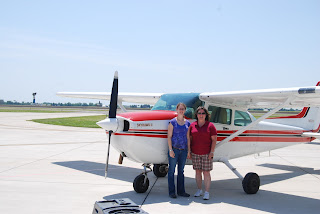May 13, 2012
After nearly three weeks of not flying, I was more than ready to take to the skies once again. We needed to practice approaches but I wanted to go somewhere new. My CFII and I started listing off all of the nearest airports with published approach procedures, then finally settled on two. We would do the ILS approach at Spirit, which is nothing new, but then we would fly out west and do the VOR-A approach into Washington. I was totally excited and ready to go.
The preflight inspection was successful, so we taxi to the runway and wait our turn to takeoff. I program the radios to the frequencies we'll need and do the airplane's run-up. While waiting, I tell Mark, my CFII, that I will be flying my Mom after the lesson for Mother's Day. I was contemplating on whether I wanted to fly her over her house, or just do the Arch tour. Before I could make my decision, I needed to make sure that I could navigate us to her house on my own. I asked Mark if I could fly without the foggles until we reach her house so that I could practice the trip. He was ok with the idea, and now we're ready for takeoff.
We had a slight crosswind on takeoff, which made for great practice in handling the situation. I did well. We depart the area to the southwest. I knew that if I just followed the river west, then made my turn to the south once I saw the new lake created by Mom's city, I would be on track. Once at the lake, I tracked the highway until her exit. I followed the road south and flew over her house. I was quiet pleased with myself; I did it! Not long after, Mark asked me to put on the foggles. Time to get to business.
He asked me to brief the approach, which meant to read my charts so that I knew what to expect. It was now time to contact St. Louis Approach. I did great with my call, except that I forgot to mention that we had Spirit's airport and weather information. Mark corrected me. The controller vectored us around to line us up for the ILS approach for runway 26Left. Once established on the approach, the controller cleared us to continue and requested that we contact Spirit's tower. "Spirit tower, Skyhawk 6-5-1-Niner-1, inbound for the ILS 26Left." She acknowledged my request and we continued on our course. It was a VFR day so we started the approach lower than what my chart says to do. Once at the final approach fix, we start the decent and set up to land. My instrument tells me that I'm still too high and a little to the right. I need to fly us down to 662ft from our current 1700ft. When we arrive at the missed approach point, Mark tells me to look up. Although I could have safely landed, I was still slightly off to the right and a little high. Not bad though. We announce that we're going missed and climb out. The tower tells us to contact approach again so we can get vectors to Washington.
We're requested to fly out to the Foristell VOR station, then let him know when we're established on the approach. Normally Mark just has me skip the procedure turn to save time, but this time he gave me the option, in which I said I wanted to practice it. After we reach the VOR station, we fly outbound for one minute, then make a right turn and follow it for one minute. Afterward, we do a 180 degree turn back toward the inbound course for one minute, while notifying Approach that we are on the VOR-A procedure turn inbound. He gives us the clearance to continue with the approach, so we make our final turn to follow it to the runway. Again, since it was a VFR day, Mark had us start the approach at a lower than published altitude. If it were an actual IFR day, you would never even consider that option. This approach requires a circle to land procedure, meaning that it does take us to the runway, but not straight in. After descending and arriving at the missed approach point, I look up to see the airport. I tell Mark that this time I actually want to land.
I take off the foggles and circle the airport to get onto the downwind leg for runway 33. We're no longer in contact with Approach, so we notify local traffic of our position. After turning onto base, then final, I bring the airplane down. My goal was to have a smooth landing. We had some crosswind but I work to correct for it. I was happy to find that the landing was very smooth. We taxi back to the start of the runway, line up, and take off.
We didn't need the help of ATC anymore, so I left my foggles off and we flew back on our own. Mark showed me some features on the Garmin 430 GPS to make navigation easier. It told me the direction that I needed to fly in order to get us back to our home airport. I was loving the fact that I wasn't wearing the foggles. The terrain around Washington airport is full of rolling forest hills, it was gorgeous. We then flew over towns and Mark helped me identify certain roads, highways, buildings and landmarks. "I could do this all day!" I thought to myself as I smiled with excitement. We arrive back at our airport, land, and taxi back to the ramp. A typical lesson is usually about 1.1 hours, however today we flew 1.6 hours and I loved every minute of it.
Now it's time to treat my Mom to a scenic flight... (see post "Mother's Day PT. 2" coming soon)






